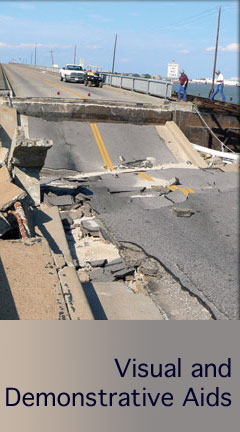Archival Notice
This is an archive page that is no longer being updated. It may contain outdated information and links may no longer function as originally intended.
Home | Glossary | Resources | Help | Course Map
As the expert gathers facts from testing and analysis, he should consider which graphic displays will help present the material in an understandable and effective way.
As findings are developed, the expert should strive to translate them into nontechnical, layman's language. The most complete investigation will be of little importance if the result cannot be relayed in a clear, effective and understandable way.
Researchers conclude that most people learn about 15 percent from what they hear and about 85 percent from what they see. Therefore, the expert must translate complex principles into visual presentations. The expert must clearly demonstrate how those principles can be applied to the facts of the case.
Visual media can be used to present technical information. When used in testimony, it must be planned early. Experts can use:
- Drawings.
- Photographs, including black-and-white and color enlargements and slides.
- Films, videos or DVDs.
- Charts and graphs summarizing voluminous data.
- Time-lapse still photography.
- Photographic enlargements or overhead projection of critical documents.
- Parts, samples or specimens of tests that were conducted.
- Microscopic examination of slides enhanced by video presentation (this technique is particularly effective for cellular or fiber analysis).
- Models and mockups of the crime site.
- Holographic presentations.
- Computer-generated or enhanced animation to demonstrate movement, time and sequence of events.
- Computer displays to portray difficult-to-observe features.
- Three-dimensional computer graphics.
- PowerPoint presentations.
Points to remember about using visual aids:
- Numerous media are available (chalkboard, overhead projector, flip chart, photographic blowups, PowerPoint).
- Dim the lights sparingly, if at all.
- Although copies of exhibits can be given to jurors, using a large projected image (blowup) is preferable.
- Leave images on view after the testimony is finished. Long exposure makes a more lasting impression on the jury.
- Be sure any visual aid is clear and legible.
- Writing the chart before the jury's eyes gains attention and fosters better understanding, but it requires advance preparation.
- If transparencies are used, provide the court with a hard copy.
- Make sure the information shown is relevant and supports your opinions.
- Visit the courtroom to see its layout, before testifying.
- Using visual aids allows the witness to walk around, which helps to hold the jury's attention.
- Visual aids should be simple and clear, should make sense, and should be easy to remember.
- Clear Plexiglas® or flexible acetate overlays can be used to display trends in related areas.
- Placing a clear overlay on the opposing expert's exhibit is an effective means of "correcting" the exhibit to reflect the expert's opinions.
Optimize the effectiveness of charts:
- Illustrate information that furthers the expert's line of argument and avoid extraneous information.
- Keep each chart simple for maximum clarity.
- When using interrelated charts, display them side-by-side to illustrate their relationship.
- Use overlays to illustrate relationships and heighten dramatic effect.
- Place labels next to plots in charts rather than in the legend. Make axis numbers large and readable, and make labels horizontal and adjacent to or within the bar, line or slice.
- Use white background and black print.
- Use scales that illustrate trends fairly.
- Use different thicknesses or colors to distinguish lines from each other and use dashed lines for projections or omissions.
- Stack colors or shades within bars from darkest at bottom to lightest at top.
This list has relevance to General Testifying Tips, on useful techniques for the witness stand. The best witnesses use demonstrative and graphic aids for maximum effect, working with counsel to obtain appropriate rulings to allow use or admissibility.
It is always effective to produce the actual item at issue (e.g., the knife, valve, coupling, electric switch, burnt fabric, or deteriorated timber). In a personal injury case involving an allegedly defective item of heavy equipment, jurors were taken to a warehouse and given an opportunity to see, sit in, and view the vehicle from the position of both the operator and the injured fellow employee.
Models can be equally effective. In one case, the expert witness prepared a full-scale model of a building that exploded in part because of a defective liquefied petroleum gas regulator valve. In another case, the expert witness prepared a scale model of a giant crane. The crane had collapsed, causing a workman's death. In a third case, the expert witness prepared a topographic model of an area subject to a partial condemnation, where resulting road elevations caused substantial damage to the remainder of the owner's land. These models became focal points for each case.
A number of national companies can provide three-dimensional digital animation simulation and interactive video production services, which experts may find useful when presenting evidence.
Additional Online Courses
- What Every First Responding Officer Should Know About DNA Evidence
- Collecting DNA Evidence at Property Crime Scenes
- DNA – A Prosecutor’s Practice Notebook
- Crime Scene and DNA Basics
- Laboratory Safety Programs
- DNA Amplification
- Population Genetics and Statistics
- Non-STR DNA Markers: SNPs, Y-STRs, LCN and mtDNA
- Firearms Examiner Training
- Forensic DNA Education for Law Enforcement Decisionmakers
- What Every Investigator and Evidence Technician Should Know About DNA Evidence
- Principles of Forensic DNA for Officers of the Court
- Law 101: Legal Guide for the Forensic Expert
- Laboratory Orientation and Testing of Body Fluids and Tissues
- DNA Extraction and Quantitation
- STR Data Analysis and Interpretation
- Communication Skills, Report Writing, and Courtroom Testimony
- Español for Law Enforcement
- Amplified DNA Product Separation for Forensic Analysts


